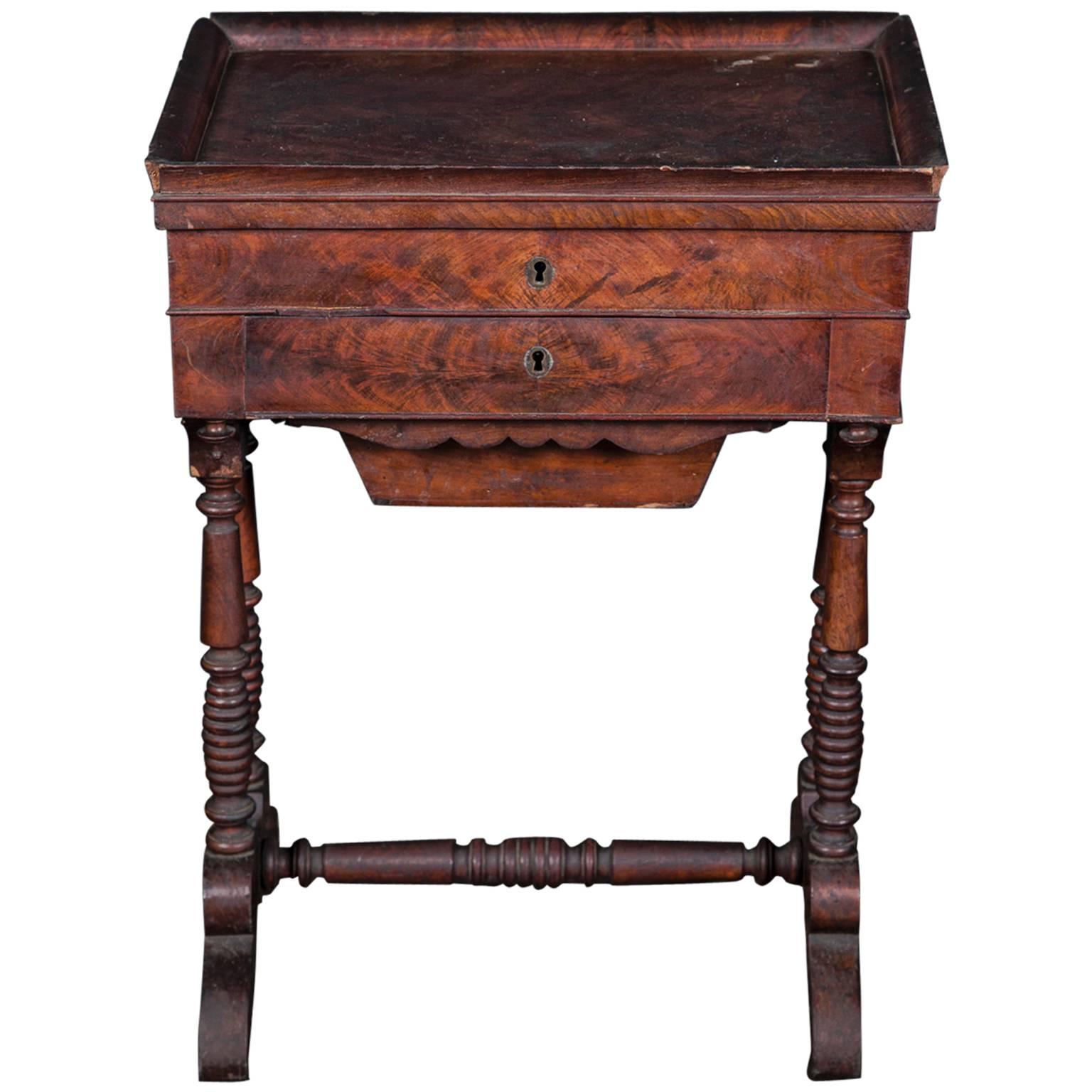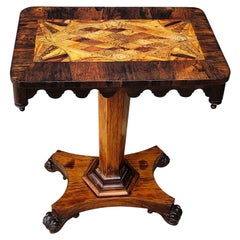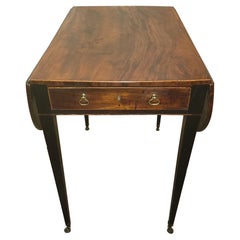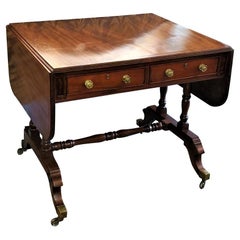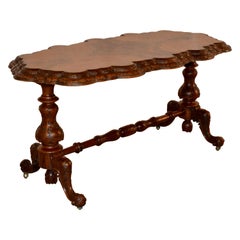Items Similar to 19th Century English Burl Walnut Sutherland Table
Want more images or videos?
Request additional images or videos from the seller
1 of 18
19th Century English Burl Walnut Sutherland Table
$3,800
£2,844.24
€3,286.56
CA$5,269.33
A$5,902.33
CHF 3,068.56
MX$72,881.90
NOK 39,090.98
SEK 36,954.44
DKK 24,526.09
Shipping
Retrieving quote...The 1stDibs Promise:
Authenticity Guarantee,
Money-Back Guarantee,
24-Hour Cancellation
About the Item
Late 19th century English drop-leaf table from the Mid-Victorian Era.
Made of gorgeous yellowish-brown walnut with a fantastic burl walnut table top. The patina on the top is simply glorious!!
The table was made circa 1850-60.
It sits on beautifully turned fluted legs with the porcelain and brass casters.
Two of the legs swing inwards and outwards to extend the 2 leaves of the table.
Fully extended the table has a fabulous curved and indented edge, in an oval shape on both ends.
The center column is beautifully turned and fluted.
The 2 side columns are again beautifully turned and fluted and end with 2 extending scrolling supports that end in turned bulbous twin feet.
This is a high quality item and highly desirable!
Antique Sutherland Tables are a Victorian invention of a much smaller gate-leg table with a particularly narrow center. It is the ideal serving table as it takes up no room when not in use and when extended can make a very large surface as the drop flaps are usually long, almost to the floor. The earliest design was first seen in the 1850s with oval leaves and standing on pedestals. These are mainly constructed in Walnut or Mahogany and the best examples are in figured Burr walnut. They are quite dainty looking antique tables but surprisingly robust when extended as they were originally used to hold a full tea service which would include cups, saucers and tea pot. They were also quite often used for games playing and writing for the Victorian Lady.
Provenance: Bought from a reputable dealer in Ireland.
Dimensions: 25.5" high, 36" wide and 44" long (fully extended)
25.5" high, 36" wide and 7.5" long (leaves down).
- Dimensions:Height: 25.5 in (64.77 cm)Width: 36 in (91.44 cm)Depth: 44 in (111.76 cm)
- Style:High Victorian (Of the Period)
- Materials and Techniques:
- Place of Origin:
- Period:
- Date of Manufacture:1850-60
- Condition:Refinished. Wear consistent with age and use. The table top has been refinished (it was sanded and waxed only) and does not have a high gloss finish. It has a matte wax finish. This only accentuates the tactile nature of the top. Otherwise it is in very good condition.
- Seller Location:Dallas, TX
- Reference Number:1stDibs: LU3978112638282
About the Seller
4.9
Vetted Professional Seller
Every seller passes strict standards for authenticity and reliability
Established in 2015
1stDibs seller since 2018
389 sales on 1stDibs
Typical response time: 1 hour
- ShippingRetrieving quote...Shipping from: Dallas, TX
- Return Policy
Authenticity Guarantee
In the unlikely event there’s an issue with an item’s authenticity, contact us within 1 year for a full refund. DetailsMoney-Back Guarantee
If your item is not as described, is damaged in transit, or does not arrive, contact us within 7 days for a full refund. Details24-Hour Cancellation
You have a 24-hour grace period in which to reconsider your purchase, with no questions asked.Vetted Professional Sellers
Our world-class sellers must adhere to strict standards for service and quality, maintaining the integrity of our listings.Price-Match Guarantee
If you find that a seller listed the same item for a lower price elsewhere, we’ll match it.Trusted Global Delivery
Our best-in-class carrier network provides specialized shipping options worldwide, including custom delivery.More From This Seller
View AllEarly 19C British Colonial Specimen Wood Side Table
Located in Dallas, TX
PRESENTING A GORGEOUS, UNIQUE and INTRIGUING Early 19C British Colonial Specimen Wood Side Table from circa 1830, the reign of William IV.
Rosewood veneered top inlaid with various ...
Category
Antique Early 19th Century English William IV Side Tables
Materials
Hardwood, Rosewood, Elm
Regency Fold over Side Table with Lions Paw Feet in the Manner of Gillows
By Gillows of Lancaster & London
Located in Dallas, TX
PRESENTING a STUNNING Early 19th Century British Regency Rosewood Fold-over Side Table with Lions Paw Feet in the Manner of Gillows.
‘Perio...
Category
Antique Early 19th Century English Regency Side Tables
Materials
Hardwood, Elm
18C Irish Georgian Mahogany Pembroke Table
Located in Dallas, TX
PRESENTING a GORGEOUS and early example of an 18C Irish Georgian Mahogany Pembroke Table.
GORGEOUS SIMPLICITY in this Mid-18th Century,
George II Period, circa 1760-80, mahogany ‘P...
Category
Antique Mid-18th Century Irish George II Drop-leaf and Pembroke Tables
Materials
Mahogany
Early 19th Century English Regency Sofa Table
Located in Dallas, TX
Presenting a stunning early 19th century English Regency sofa table.
Made from flamed mahogany, circa 1810-20.
Drop leaves on either s...
Category
Antique Early 19th Century English Regency Sofa Tables
Materials
Brass
Pair of 19C French Country Cherrywood Side Tables
Located in Dallas, TX
PRESENTING a LOVELY Pair of 19C French Country Cherrywood Side Tables.
Not a fully ‘matching’ pair, but very similar and have been together since the 1930’s (at a minimum).
Both ma...
Category
Antique 19th Century French French Provincial Side Tables
Materials
Porcelain, Cherry
Pair of 18C Country French Cherrywood Open Shelved Side Tables
Located in Dallas, TX
PRESENTING a LOVELY Pair of 18C Country French Cherrywood Open Shelved Side Tables.
Both from circa 1790 and made of cherrywood, these beautifully proportioned side tables are not f...
Category
Antique Late 18th Century French French Provincial Side Tables
Materials
Cherry
You May Also Like
19th Century English Walnut Sutherland Table
Located in High Point, NC
19th century walnut Sutherland table from England. The top has a burl walnut central panel, surrounded by lovely walnut banding and mahogany and satinwood borders as well. The top ...
Category
Antique 19th Century English High Victorian Side Tables
Materials
Boxwood, Mahogany, Walnut
French 19th Century Burl Walnut Poudreuse Table
Located in New Orleans, LA
This mirrored hinged-top burl walnut poudreuse is fitted beautifully with an interior of rare pear wood. Dating back to the 19th century, the French antique piece sports a locked drawer below, also lined with pear wood, and a deep bottom drawer with brass escutcheons. Finally, the four legs and stretcher at bottom are carved and turned in the classic style of the Louis-Phillippe period.
The piece is part of the collection from The French Antique Shop...
Category
Antique Late 19th Century French End Tables
Materials
Mirror, Wood
19th Century English Burl Walnut Table
Located in High Point, NC
Superb quality late 19th century burl walnut stretcher table with a double beveled, scalloped and relief carved edge. The top is exquisitely grained - an absolute show stopper! The l...
Category
Antique 19th Century English High Victorian Console Tables
Materials
Walnut, Burl
Victorian Burl Walnut Sutherland Table
Located in Montreal, QC
This is a fine example of a Victorian Sutherland table, one of the most intelligent and practical innovations in Victorian furnishing. This table is of gatefold leg design with twin ...
Category
Antique Late 19th Century English Victorian Drop-leaf and Pembroke Tables
Materials
Walnut
Outstanding Quality Antique Victorian Burr Walnut Sutherland Table
Located in Suffolk, GB
Outstanding quality antique Victorian burr walnut Sutherland table having a wonderful quality burr walnut top with two drop leaves and a moulded edge supported by elegant turned tape...
Category
Antique 19th Century English Victorian Drop-leaf and Pembroke Tables
Materials
Walnut
Burr Walnut Sutherland Table
Located in Cheshire, GB
Victorian figured walnut Sutherland table, the shaped top with two impressive burr walnut leaves. Supported on two turned supports united by st...
Category
Antique 19th Century British Side Tables
Materials
Walnut

